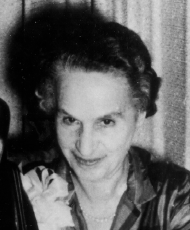 Welcome
to CWP at UCLA
Welcome
to CWP at UCLA  Welcome
to CWP at UCLA Welcome
to CWP at UCLA |
|
86 Eminent Physicists |
Particles and Fields
|
|
Contributions Publications Honors |

Marietta Blau1894-1970 |
Education Additional Information |
Some Important Contributions
Pioneering work in the photographic method of studying particle tracks. She
created emulsions with characteristics and development conditions that
allowed for observation and measurement of
proton tracks.
Worked with Ilford (UK) to obtain thick emulsions, and discovered development techniques to observe and measure track of higher energy protons and used these to study and detect protons and other heavy particles in cosmic rays.
Showed there were relatively large numbers of protons and neutrons in
cosmic radiation. Observed nuclear disintegrations caused by cosmic rays in nuclear emulsions, with H. Wambacher. These were known before WWII as Blau-Wambacher stars.
Early development of photomultiplier tubes.
Some Important Publications"The photographic effect of natural H-rays," (in German), SBAWW (Sitzungsberichte Akademie der Wissenschaften in Wien) IIa 134: 427 (1925). "The photographic action of H-rays," ibid., 136: 469 (1928).
"Photographic detection of protons liberated by neutrons. II,"
ibid., 141: 617 (1932), with Hertha Wambacher. "Physical and chemical investigations on the method for the photgraphic detection of H-rays," ibid., 143: 285 (1934), with Hertha Wambacher. Disintegration Processes by Cosmic Rays with the Simultaneou Emission of Several Heavy Particles," Nature 140: 585 (1937), with Hertha Wambacher. "Photographic Tracks from Cosmic Rays," Nature 142: 613 (1938).
"The multiplier phototube in radioactive measurements," RSI
18: 715 (1947).
"Meson production by 500 Mev negative pions," Phys. Rev. 92: 516 (1953)
with M. Coulton and J. E. Smith.
"Hyperfragments and slow K- mesons in stars produced by
3 Bev protons," Phys. Rev. 102: 495 (1956). "Interaction of 750 Mev pi- mesons with emulsion nuclei," Phys. Rev. 102: 489 (1956) with A. R. Oliver. Honors
Ignaz L. Lieben Prize of the Viennese Academy of Science, with H. Wambacher, 1937
E. Schrödinger Prize, with H. Wambacher(posthumous), 1962 Nominated several times for the Nobel Prize by E. Schrödinger. [LH] Jobs/Positions[ref. [33B LSG] and [MBCV] Marietta Blau's CV; English translation courtesy Ruth Lewin Sime ]
1920-21 a position in industry in Berlin [MBCV]
1921-23 Assistent, University-Institut, Frankfurt am Main 1923-1938 Unclassified (unpaid) position, Institut fur Radiumforschung and at Second Physical Institute, University of Vienna 1939-44 Professor, Technical University, Mexico City 1944-48 International Rare Metals Refinery, NY, the Gibbs Manufacturing and Research Corporation, and then the Canadian Radium and Uranium Corporation 1948-50 Research physicist (?), Columbia University 1950-55 Associate physicist(?), Brookhaven National Laboratory at the invitation of the Atomic Energy Commission 1955-60 Associate Professor, University of Miami EducationPh.D. University of Vienna 1919 Sources and References
|
To cite this citation:
" Blau, Marietta." CWP
< home >